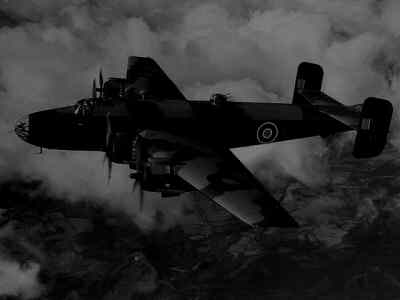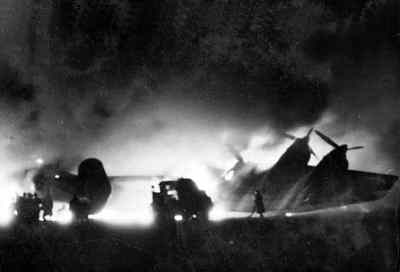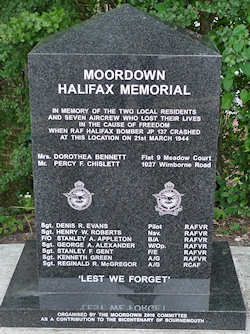|
Air crash on Moordown
Eyewitness account from Russ Barnes
Halifax Aircraft JP137. * Unit 1865 CU - with
five aircrew
A little after 1.0am on 22nd
March 1944, RAF Halifax Bomber, JP137 took off from Hurn Aerodrome.
It appears that during the first few minutes of flight a serious
engine malfunction occurred.

Flying westerly, but now turning in a wide arc,
presumably in an attempt to return to Hurn, it flew over East
Howe towards Wallisdown turning south over Talbot woods and due
east when over Winton. It was a clear night and the impression
was that the pilot, who was fast losing height, was attempting
to follow the main Wimborne Road towards Hurn.
A subsequent witness reported that flames were clearly
visible from an engine that was misfiring and spluttering.
My family and I lived at 1012 Wimborne Road, a corner
house built on the junction of Wimborne Road with Comber Road
and opposite Hillcrest and Priory View Road to the south.
At the time of the air crash I was sleeping on the
ground floor, inside a steel 'Morrison' table shelter
My father, Herbert 'Bert' Barnes was exempt from
military service on grounds of his age and trade as a printer's
compositor. At the beginning of hostilities (1939) he volunteered
for the A.R.P (Air Raid Precautions) and by early 1940 was one
of the first Wardens. He subsequently helped to supervise the
Moordown area designated by the Civil Defence as Sector B3. Initially
from a garage of a private house in Barrie Road and later, with
telephones and additional equipment, out of rooms which are now
the sports pavilion of the Public Bowling Green in Redhill Avenue,
Ensbury Park.
Engine trouble
The noises of the approaching aircraft aroused me.
It was obviously in trouble because the screeching engine roar
fading to a splutter and returning to a roar indicated a serious
problem; clearly the pilot wrestling with the controls was nonetheless
losing height and gave dawn to the realisation it was heading
towards us and was going to crash - but when and where?
The engine roar, abruptly diminishing to a whisper,
was instantly followed by sharp 'cracking' sounds less than a
second or so apart. A rushing of air.
A loud impact followed by a metallic grating slithering
noise increasing to a finalé of rending tearing metal.
Then an eerie silence in which a man could be heard screaming
- a sound I will never forget.
Then an explosion of the petrol tanks, which showered
the nearby houses with fragments of metal that rattled down the
roof tiles and fell on the path outside my window.
My father, who had not long been home from ARP duty,
was dressed in moments and out of the house; grabbing his garden
spade as he ran.
Diagonally opposite us, numbered as 1025 to 1031
Wimborne Road, was a pair of semi-detached of Victorian cottages
homes providing four dwellings with a common entrance gravel path
between them. The flames of this roaring inferno were some fifty
feet high above their rooftops and it was evident the aircraft
had come to rest across their immediate back gardens.
I quickly dressed and tried to join my father who
severely admonished me and ordered me back home. A Mr. Dave Smith
from 1035 had joined Dad.
In the distance the approaching clamour of a Fire
engine bell could be heard. . The National Fire Service Stationed
on Peters Hill had anticipated a crash and had set off 'in pursuit'.
Emergency response
Travelling up the Wimborne Road (from Northbourne)
and heading into Bournemouth was a convoy of American Army vehicles.
They, of course, had seen events from some distance away and now
having reached the scene stopped in the road outside the cottages
to help.
The Fire Engine arrived; however, because of the
US vehicles couldn't get near the site. The Americans were helpful
and hose lines were run from a wartime static water tank purposely
built on the corner of Hillcrest and Wimborne Road (adjacent to
Wing Motors).
The backs of the cottages were ablaze and ammunition
exploding with the heat exacerbated the problems. Bullets were
flying everywhere and everyone was apprehensively wondering if
it was carrying high explosives?
At cottage 1027 Mrs. Chislett and her fourteen-year-old
son John dressed only in their nightclothes escaped by jumping
from a front upstairs window but the fall onto gravel caused injuries.
They lost everything. All they had in the world was just their
nightclothes and not a penny more.
Mr. Percy Chislett could not be seen. Forcing the front door by
using his spade as a lever Dad found him dead upstairs in his
bed. He also found the badly mutilated body of an aircrew member
lying close to the main Wimborne Road.
The fire blazed for an hour although the ammunition
was still exploding long after.
The Casualties
Dawn revealed the horror that at least seven people had perished:
Mr. Percy Chislett od 1027 Wimborne Road, and Mrs
Dorothea Bennett in Flat 9 on the ground floor of the adjacent
'Meadow Court.
The seven aircrew members were:.
Pilot Sgt. Dennis Evans, 20yrs, from Middlesex
Navigator Sgt Henry Roberts
Air Gunner Sgt. Reginald McGregor, 21yrs, from New Westminster,
British Columbia
Flight Engineer Stanley Gent, 22yrs, from Portslade
Wireless Operator Sgt George Alexander, from Bedford
Bomb Aimer F/O Stanley Appleton
Air Gunner Sgt Kenneth Green
The bodies - or what was left of them - were carried
across the road into a storeroom (probably a small coach house)
of 'The Hollies' Public House, which was designated as a temporary
mortuary. Sadly, but understandably, the trauma of these events
temporarily disrupted the emotional and mental stability of the
licensee.
By dawn's breaking the RAF were swarming over the
site and armed guards were posted. Very little of what was left
of the plane - which was upside-down - was recognisable. What
remained of the tail section was close to a hole smashed through
the lower half of the east corner wall of Meadow Court, adjacent
to where Mrs Bennett perished.
Pilot tried to save lives
Slowly the chain of events was revealed. Clearly
Pilot Sgt. Dennis Evans, was trying to reach Hurn but the failing
engine meant that maintaining height was impossible and inevitably
they were going to crash.
Realising he must make the best of a ghastly situation
he was faced with some awesome decisions. How to avoid the dense
housing and protect many civilian lives, yet ensure the safety
of his crew. With just seconds left in the air this must have
been a terrible ordeal for the twenty-year old man
 Mrs.
Joan Gray, of Surrey, (who in 1944 was Miss Joan Davies, of 907
Wimborne Road), vividly recalled that at the time the Halifax
was flying across King Edward and Bloomfield Avenues it was only
a few feet from their rooftops. Mrs.
Joan Gray, of Surrey, (who in 1944 was Miss Joan Davies, of 907
Wimborne Road), vividly recalled that at the time the Halifax
was flying across King Edward and Bloomfield Avenues it was only
a few feet from their rooftops.
"The 'cracks' I heard was the aircraft's under
fuselage, or lowered undercarriage perhaps, colliding with the
roof tops of Willis's Builders Merchants, the Bus Depot and the
front gable of a house in Malvern Road. He could only have been
thirty foot or less from the ground. "
The consensus of opinion at the time was that Sgt
Evans could probably see the fairly large expanse of open ground
(as it was then) behind the houses of Wimborne Road and it was
his last chance to crash land.
He flopped the aircraft down onto the open space
behind the homes of Frank Claw, (Malvern Road), Steve Barnes and
Mr. Tom Plowman or Ploughman, who had a long section of ground
with animals, (Wimborne Road), but collided with the six or so
timber framed and asbestos clad garages built in a line at the
foot of the Meadow Court communal garden.
The aircraft continued to slither along the surface
for some ninety or more yards but then a steep rise in the ground
approaching the rear of the cottages was a barrier. Here the plane
somersaulted and disintegrated.
With a full load of aviation-fuel, the ensuing inferno
destroyed everything in the vicinity.
An engine was catapulted in the air travelling some
one hundred and fifty yards above the rooftops of houses in Hillcrest
Road, narrowly missing the home of the Appleton family, finally
coming to rest in soil by the static water tank a few yards from
'Wing Motors' run by Johnny Arnold.
Mystery destination
The RAF told my father that the plane was heading
for Middle East/India with supplies.
Certainly there were many hundreds of what appeared
to be small medicinal tablets scattered over the site. But India
is a very long journey.
They could not fly over a Europe that was still
very much under German command. Fly due west and then south around
Spain perhaps but where could they re-fuel. Gibraltar possibly
?
A story (rumour !) that emerged later was that they
were on a clandestine journey to Europe to drop supplies, ammunitions
perhaps - or even someone by parachute - to the underground movements.
Although we had no idea, D-Day and the Normandy landings were
just twelve weeks away, perhaps an ideal time to drop supplies
or an agent into Europe, so was that why the RAF mounted a strict
armed guard over everything ?
Years later a report said seven aircrew died. Then
someone found a record that on the same date a F/Lt Norval Pollock,
flying a Hurricane, had perished in a Bournemouth air crash and
was buried in North Cemetery (the Cemetery records apparently
state that).
However, I understand, no record of that crash exists.
There was also talk of a midair collision between
an American and British aircraft somewhere in an area bounded
by Winkton, Sopley and Christchurch - but not on the 21st March
- however we must accept that wartime records were often a broad
statement.
Eerie coincidence
Nonetheless, there remains an amazing; some may
say uncanny aspect to this tragic incident. Three members of the
aircrew had the  surnames
Gent, Appleton and Evans: you will probably agree the first two
surnames are not common. surnames
Gent, Appleton and Evans: you will probably agree the first two
surnames are not common.
Within yards of the crash site lived three families
Gent (Wimborne Road), Appleton (Hillcrest Road) and Evans in one
of the cottages destroyed.
Anyone care to analyse the mathematical probabilities
of that coincidental paradigm?
* Doubts have been expressed about the aircraft's
unit number - was there a slight corruption of figures.
© 2007 Russ Barnes, Dorset
Memorial
A memorial to the crew and civilians who died in
the crash was erected in 2011. It stands at the scene of the disaster
on the corner of Meadow Court Close and Wimborne Road.
|